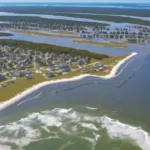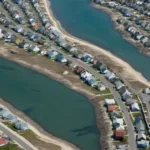21 November 2023
Rising Sea Levels Threaten Coastal Areas Across the United States
As the effects of climate change continue to unfold, coastal communities across the United States are facing a growing threat from rising sea levels. From the picturesque beaches of California to the historic towns of New England, the impact of this environmental crisis is becoming increasingly apparent. This article delves into the challenges faced by these communities, the potential consequences for both the environment and local economies, and the urgent need for action.
1: Vulnerable Communities at Risk
Coastal communities in states such as Florida, Louisiana, and North Carolina are particularly vulnerable to the effects of rising sea levels. As sea levels continue to rise, these areas face an increased risk of flooding, erosion, and storm surges. The threat is not limited to densely populated cities but also affects smaller towns and rural areas that rely on coastal resources for their livelihoods.
2: Environmental Impact
The rising sea levels pose a significant threat to coastal ecosystems. Saltwater intrusion into freshwater sources can contaminate drinking water supplies, endangering both human and animal populations. The loss of coastal wetlands, which act as natural buffers against storms and provide vital habitats for numerous species, further exacerbates the environmental impact of rising sea levels.
3: Economic Consequences
Coastal communities are not only facing environmental challenges but also economic ones. Many of these regions heavily rely on tourism, fishing, and other coastal industries. With the increasing frequency and intensity of storms, the infrastructure and property damage caused by flooding can have devastating effects on local economies. Additionally, the loss of beaches and coastal habitats can deter tourists, leading to a decline in revenue for businesses and communities.
4: Mitigation and Adaptation Strategies
To address the challenges posed by rising sea levels, coastal communities are implementing various mitigation and adaptation strategies. These include beach nourishment projects, the construction of sea walls and levees, and the restoration of coastal wetlands. Additionally, some communities are exploring managed retreat, relocating residents and infrastructure away from vulnerable areas. However, these strategies come with their own set of challenges, including high costs and potential impacts on ecosystems.
5: The Role of Government and International Efforts
Addressing the impact of rising sea levels requires a coordinated effort at all levels of government. The federal government plays a crucial role in funding and supporting research, infrastructure projects, and community resilience initiatives. Internationally, the Paris Agreement has set targets for reducing greenhouse gas emissions and promoting climate resilience. However, the effectiveness of these efforts depends on global cooperation and commitment.
Conclusion:
The threat of rising sea levels is a pressing issue that demands immediate attention. Coastal communities across the United States are already experiencing the consequences of climate change, and without decisive action, the situation will only worsen. It is crucial for governments, communities, and individuals to work together to mitigate the impact of rising sea levels, protect vulnerable areas, and ensure the long-term sustainability of coastal communities. Only through collective action can we safeguard our coastal heritage and secure a more resilient future for generations to come.



